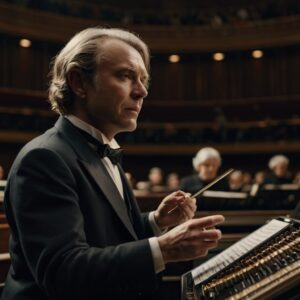At the mention of classical music, thoughts often gravitate towards the musicians on stage, each one mastering his or her instrument with great skill. Yet one figure remains above all of this, bringing together each individual part into a cohesive whole – the conductor. His or her job is to forge an interpretation of the music based on a very deep analysis of the score, looking for the nuances and intent within. A conductor excavates emotions and insights from the page, and then, in their mind’s eye, sees how they will be projected through the ensemble.
To truly set a compelling interpretation, a conductor must possess an intimate understanding of the historical elements surrounding the work’s composition. Events in the world, in the composer’s personal life, or even changes in instrument technology at the time of writing can drastically shift the colors of a piece. Based on insights like these, the very same symphony could sound entirely different depending on who’s conducting it. The interpretation we hear is therefore the maestro’s personal touch, which comes largely from an expansive base of knowledge.
The act of conducting is fundamentally about communicating these interpretations to the ensemble during rehearsals. With words, gestures, and sometimes even metaphors, the conductor turns these insights into actual advice, molding the way each section will voice its part. The conductor leads musicians to some understanding beyond the note itself, integrating individual prowess into a grander narrative.
Synchronizing Sound
The conductor is the most important timekeeper within the ensemble. Like a living metronome, he or she will vary the tempo and rhythm so that the brass does not cover the strings or that the woodwinds come in with their ethereal whisper just as the violins decrescendo.
Musicians look for individual signals. The conductor will make small changes in energy with a flick of the wrist, a tilt of the baton, or a raised eyebrow, which may involve a change in tempo or dynamics. It is a complicated system of non-verbal communication, like an elaborate form of sign language. The ability to apply such changes instantly and achieve synchronization within the ensemble reveals the art of conducting.
In a small chamber group, changes of tempo may seem more organic, but in a large orchestra, the slightest discrepancies in timing lead to chaos. This is why the conductor is indispensable in preserving unity among the musicians, allowing each of them to focus on his part, knowing that the larger picture is under control.
 The Music Coach
The Music Coach
Conductors are coaches, dedicated to drawing out the best performance from each musician. Think about an orchestra as a finely tuned sports team. Just as a coach would guide athletes through strategies and pitfalls, conductors do the same. They foster an environment where musicians feel inspired and supported to play with both technical precision and emotional depth.
They pick apart trouble spots, spots that need tightening, or phrases that require more expressiveness. They harness their deep understanding of instrument technique and musical theory to offer practical advice. By creating a space where musicians feel free to ask questions or express concerns about certain passages, they build trust. This directly affects performance quality, as musicians who feel valued tend to be more expressive and connected.
Conductors mentor musicians in honing their craft, often providing personal feedback about technique, articulation, or stylistic interpretation. Through constructive criticism and encouragement, conductors play a big role in the professional development of countless musicians. Over time, these interactions build camaraderie and transform the ensemble into an interconnected group striving for collective greatness, ready to channel their skills into a memorable performance.
The Charismatic Presence
The conductor’s presence alone can shift the concert’s energy, engaging listeners long before the first note sounds. When a conductor steps up to the podium, their demeanor, gestures, and charisma capture attention and instill anticipation.
Audience perception can vary drastically based on how much a conductor gets involved. A dynamic conductor who visibly and audibly demonstrates passion can draw the audience deeply into the music. Observing a conductor lose themselves in a crescendo or guide an orchestra through a tumultuous passage can be profoundly moving for those witnessing the performance.
Conductors often take steps to educate audiences. Pre-concert talks, discussions about the works and their history, and addressing audience questions allow them to demystify classical music’s often complex world. By bridging this gap, they transform concertgoers into informed listeners, thus enhancing their experience and appreciation for the art form. Conductors become vital liaisons in not only performing music but in nurturing an audience’s lifelong love of it.
The Innovator
Innovation is always in the air, and it is conductors who are often the first to draw it in. They have a significant role in refreshing classical repertoire—finding new ways to interpret timeless works, infusing new elements into them, or adding variety to keep classical music always changing and current.
Conductors are not afraid to alter things in the orchestra. This could involve something as simple as changing the seating arrangement to try out different sound mixtures, or something as elaborate as integrating multimedia aspects into performances so that the audience might enjoy a multisensory experience. Some might even go so far as to commission new works that address contemporary social issues. Such innovations can breathe new life into the concert experience, attracting broader and younger audiences who might otherwise find traditional settings intimidating.
They give audiences of today rare listening experiences by bringing back and reviving works that haven’t been performed in decades, things that once had dust on them and were forgotten. It’s a perfect merging of the honoring of the past with the stimulating of curiosity for something new. The baton is in the hands of the conductors to push such innovations from within the orchestra to the major concert halls of the world.
The Diplomat
Orchestras consist of diverse groupings of musicians, each with their own artistry and style. The conductor must be a diplomat to ensure that collaboration is both smooth and productive. It’s a complex undertaking that calls for skillful negotiation, sensitivity to individual feelings, and the ability to inspire unity without suppressing creativity.
When conflicts arise—whether over music or due to personality frictions—resolving such problems becomes a significant function of the conductor’s job. He must listen, wade through the thickets of personal relationships, and, where necessary, mediate to secure peace.
In this artistic collaboration, the conductor encourages the musicians to strive for a common ideal while permitting them to express their individuality. Especially in larger orchestras, where sections might naturally form their own identity, conductors spend time ensuring each player’s voice is heard and valued within the collective ensemble.
